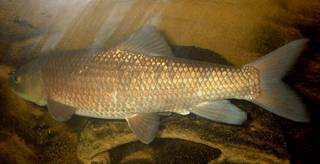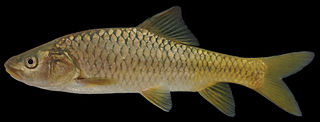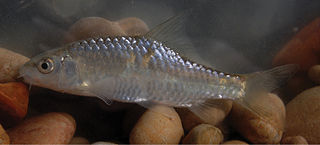
The International Union for Conservation of Nature (IUCN) Red List of Threatened Species, also known as the IUCN Red List or Red Data Book, founded in 1964, is an inventory of the global conservation status and extinction risk of biological species. A series of Regional Red Lists, which assess the risk of extinction to species within a political management unit, are also produced by countries and organizations.

The Chao Phraya River is the major river in Thailand, with its low alluvial plain forming the centre of the country. It flows through Bangkok and then into the Gulf of Thailand.

Inia is a genus of river dolphins from South America, containing one to four species.

Barbus is a genus of ray-finned fish in the family Cyprinidae. The type species of Barbus is the common barbel, first described as Cyprinus barbus and now named Barbus barbus. Barbus is the namesake genus of the subfamily Barbinae, but given their relationships, that taxon is better included in the Cyprininae at least for the largest part.

The East African oryx, also known as the beisa, is a species of medium-sized antelope from East Africa. It has two subspecies: the common beisa oryx found in steppe and semidesert throughout the Horn of Africa and north of the Tana River, and the fringe-eared oryx south of the Tana River in southern Kenya and parts of Tanzania. The species is listed as Endangered by the IUCN.

The kisslip himri or Kosswig's barb is a species of cyprinid fish of the genus Carasobarbus that is found in the Tigris-Euphrates river system in Iran and Turkey. It was originally described as Cyclocheilichthys kosswigi.

The Algerian barb or Tunisian barb, is a ray-finned fish species in the family Cyprinidae. It is found in Algeria and Tunisia.

The Jordan himri is a ray-finned fish species in the family Cyprinidae.

Carasobarbus harterti, the stripeless himri, is a ray-finned fish species in the family Cyprinidae. It is found only in Morocco.
Carasobarbus moulouyensis is a ray-finned fish species in the family Cyprinidae. It is found only in Morocco.

The Permanent Maghreb of World Wide Fund for Nature is a freshwater ecoregion of North Africa.

Boto is a Portuguese name given to several types of dolphins and river dolphins native to the Amazon and the Orinoco River tributaries. A few botos exist exclusively in fresh water, and these are often considered primitive dolphins.

The wildlife of Pakistan comprises a diverse flora and fauna in a wide range of habitats from sea level to high elevation areas in the mountains, including 195 mammal, 668 bird species and more than 5000 species of Invertebrates. This diverse composition of the country's fauna is associated with its location in the transitional zone between two major zoogeographical regions, the Palearctic, and the Oriental. The northern regions of Pakistan, which include Khyber Pakhtunkhwa and Gilgit Baltistan include portions of two biodiversity hotspot, Mountains of Central Asia and Himalayas.

The Bolivian river dolphin is a species of the genus Inia.

Carasobarbus, the himris, is a small genus of ray-finned fishes in the family Cyprinidae. Its species are found in rivers, streams, lakes and ponds in Western Asia and Northwest Africa. C. canis can reach 66 cm (26 in) in total length, but most other species are up to around half or one-quarter of that size.

Labeobarbus is a mid-sized ray-finned fish genus in the family Cyprinidae. Its species are widely distributed throughout eastern Africa and especially southern Africa, but also in Lake Tana in Ethiopia. A common name, in particular for the southern species, is yellowfish. The scientific name refers to the fact that these large barbs recall the fairly closely related "carps" in the genus Labeo in size and shape. As far as can be told, all Labeobarbus species are hexaploid. One species, L. microbarbis from Rwanda, is known to have gone extinct in recent times.

Capoeta damascina, the Levantine scraper or Mesopotamian barb, is a species of cyprinid fish from the Near East region. It is reported from Iraq, Israel, Jordan, Lebanon, Syria, Iran and Turkey.

The Mesopotamian himri is a species of ray-finned fish in the genus Carasobarbus.

The Arabian himri is a species of ray-finned fish in the genus Carasobarbus. It is endemic to Saudi Arabia in wadis in the Hijaz Mountains which either drain into the Red Sea or inland.

Carasobarbus sublimus is a species of ray-finned fish in the genus Carasobarbus. It is endemic to the River Tigris in Iran and Iraq.



















